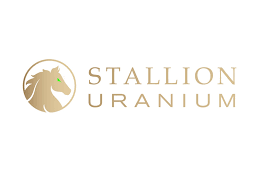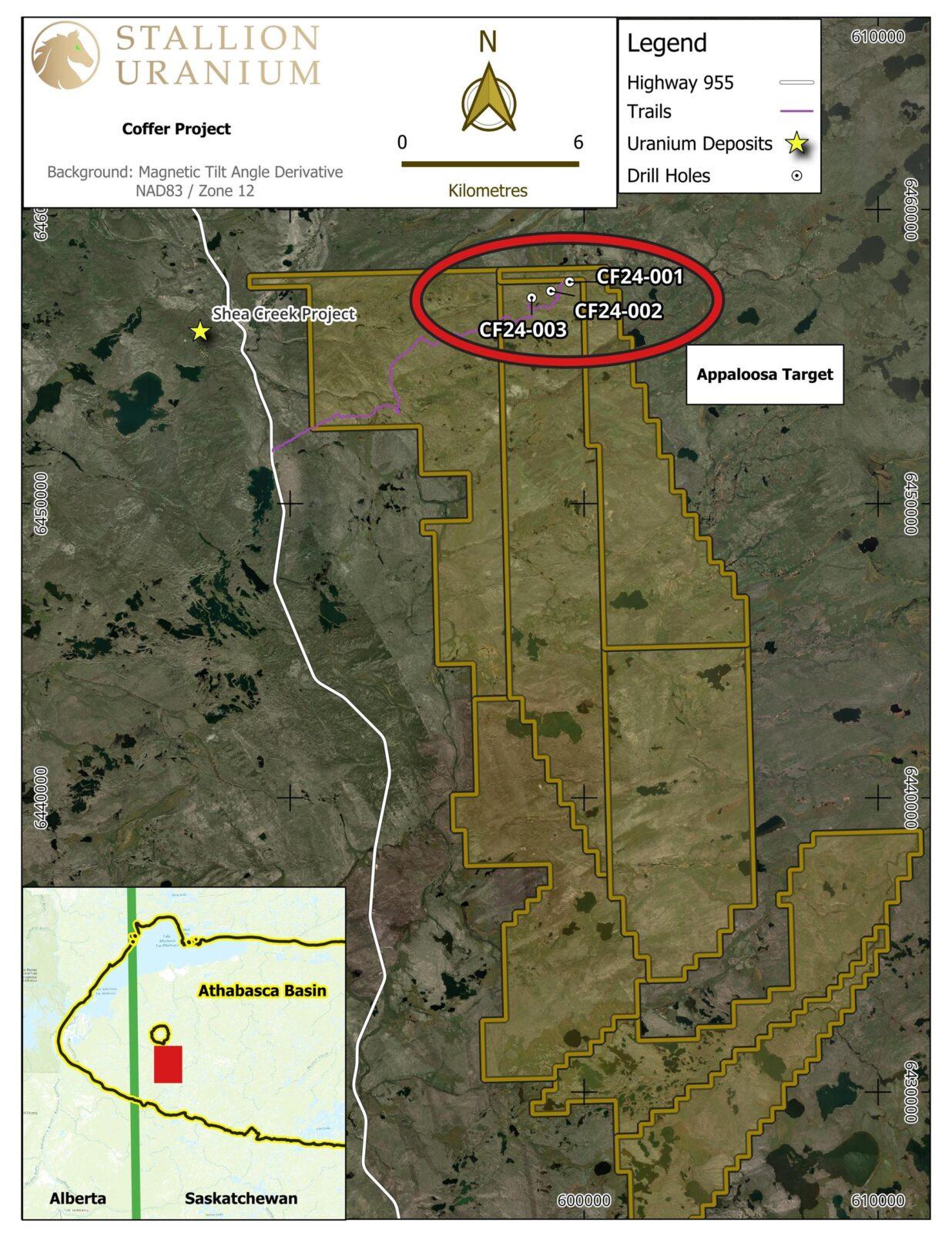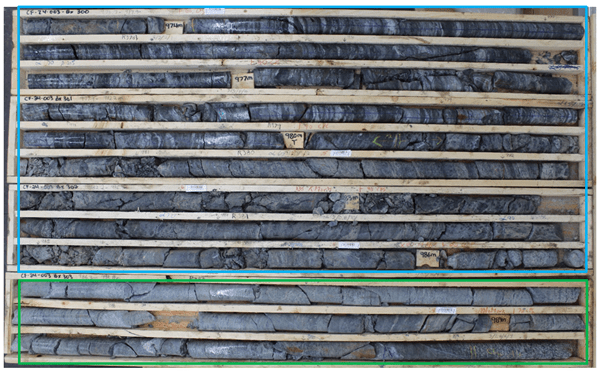
Stallion Uranium Intersects Significant Conductive Structure

Stallion Uranium Corp. (TSX-V: STUD) (OTCQB: STLNF) (FSE: HM40) is proud to announce the successful completion of their inaugural winter 2024 diamond drilling program on its 100% owned Coffer Project situated in the prolific Southwestern Athabasca Basin in Saskatchewan, Canada. This milestone initiative was successful in encountering anomalous radioactivity in all three drill holes and culminated with the discovery of a large, deep-rooted conductive structure intersected on the final drill hole CF24-003 giving the target area the characteristics needed to host a large uranium deposit.
Highlights
- Three diamond drill holes totaling 2,798.2m were completed at the Appaloosa target area (Figure 4).
- Hole CF24-003 intersected the unconformity at 720 m and was completed at a depth of 1055 m.
- CF24-003 is located 700 m west along strike from CF24-002, and 1.4km west of CF24-001.
- Anomalous radioactivity was encountered at the unconformity in all three holes.
- A total of 282 whole rock samples were obtained for assay, including interval and selective samples.
- A deep-rooted conductive structure, spanning 94.7 meters in down-hole thickness, was encountered in hole CF24-003 highlighting the significant size of the structure.
- Strong clay and chlorite alteration which is known be is associated with uranium mineralization was encountered.
- Stallion holds a 100% ownership of the project.
“Stallion’s winter 2024 drilling program at the Coffer project has yielded remarkable results, identifying a large conductive structure and 1.4 km of anomalous radioactivity at the unconformity across all three drill holes. The third hole intersected significant alteration and structure, and given the size of those intersections, indicate that the Appaloosa target possesses the characteristics capable of hosting a substantial uranium deposit. Further processing and modeling of the data collected will provide enhanced targeting capabilities, greatly increasing the probability for discovery on a future program,” commented Darren Slugoski, Vice President Exploration, Canada.
Winter Drill Program Summary
Stallion’s maiden drill program commenced on March 6, 2024, to drill test geophysical targets derived from both regional and advanced ground surveys. A total 2,798.2m of diamond drilling was completed over 3 holes, all of which were successful in encountering anomalous radioactivity at or above the unconformity. The final hole targeted and intersected the conductive structure, with an intercept of over 94m, highlighting the size and ability of the structure in transporting uranium bearing fluids. The significant size of the structure adds to Stallion’s view that not only is the structure fertile for a uranium deposit but has the potential to host a large deposit.
The drill program successfully identified the key characteristics of a uranium bearing system and the promising findings validate Stallion’s geological model, allowing for building confidence in the target area. The structural elements and scale encountered, along with anomalous radioactivity throughout, are strong indicators the Appaloosa target has the potential to host a significant uranium discovery. The winter drill program only tested 1.4km of the extensive 3.5-kilometre-long conductive zone, giving the target area further size and exploration potential.
The company is currently in the process of compiling and analyzing all data acquired during the drilling program. Stallion will leverage this comprehensive analysis to inform future exploration efforts and guide the development of an optimized exploration strategy for the target area moving forward.
“Our maiden drill program was a game-changing moment for Stallion, as we not only uncovered radioactivity in every hole, but also struck a massive conductor that unveiled the size of the structure at Appaloosa. Our confidence in the Appaloosa target’s potential continues to grow given the results of the drill program, providing us with the information needed to vector towards a discovery,” declared Drew Zimmerman, CEO. “Our drill program proved to be a resounding success, showcasing our ability to swiftly navigate from greenfield to drill testing in just 14 months. This achievement highlights our strategic approach to uncovering the next major uranium discovery. By systematically uncovering high-potential targets within our extensive portfolio of conductive corridors, we are maximizing the probability of success in all future exploration endeavors.”
Technical Summary for CF24-003
(Zone 12 V 598215 Easting, 6456999 Northing, 0000 Azimuth / Dip -800)
CF24-003 is located 700 metres west of CF24-002 (Figure 4) and targeted an EM conductor that was located within a coincident gravity low. CF24-003 was successful in explaining the conductive anomaly as well as intersecting a substantial deep-rooted structure. Two anomalous radioactive intervals were encountered in the Athabasca Sandstone above the unconformity with radioactivity of 356 cps over 0.5 m with a radioactive peak of 590 cps and 336 cps over 1.3 m with a radioactive peak of 616 cps (Table 1). A RS-230 BGO Super-SPEC Handheld Gamma-Ray Spectrometer measured a radioactive peak of 110 counts per second (“cps”) and a Mount Sopris 2PGA-1000 downhole gamma probe measured a radiometric peak of 616 cps at 718.3m depth. The unconformity was intersected at 720.0 m followed by the discovery of intensity silicified rock at 876.1 m at the upper contact of the deep-rooted structure. The graphitic structure begins at 880.6 and hosts brittle and ductile shear intervals as well as strongly clay and chlorite altered minerals known to be associated with uranium mineralization.
Table 1: Downhole Total Gamma Results from CF24-003
| Hole Number | From (m) | To (m) | Width (m) | Avg. cps | Peak cps | Rock Type |
| CF24-003 | 715.3 | 715.8 | 0.5 | 356 | 590 | Sandstone |
| And | 717.3 | 717.6 | 1.3 | 336 | 616 | Sandstone |
| CF24-003 (Figures 1 to 3) |
|
Figure 1 –Example of graphitic structure with associated clay alteration from 973.7 to 990.8m. |
|
Figure 2 – Close up graphitic structure at 969.9m. |
|
Figure 3 – Example of strong clay chlorite alteration from 933.8 to 940.7m. |
Diamond Drilling
Three holes were completed at the Appaloosa target for a total of 2798.2 m (Figure 1), less meterage than planned given the unconformity was shallower than anticipated. Drilling was successful in intersecting a significant conductive structure, along with significant clay alteration and anomalous radioactivity. The company has sent a total of 282 samples from the 3 holes to be assayed at the SRC Geoanalytical Laboratories in Saskatoon, Saskatchewan. The company will release assays and geological models when available.
Appaloosa Target
The Appaloosa target is located at the north end of the 100% owned Coffer project and was first identified from the regional VTEM survey conducted in early 2023. The survey data when compiled and modeled with all available historical data showed the key characteristics for potential uranium mineralization. To best refine drill targets Stallion utilized the latest technology to complete an advanced ground TDEM survey over the target area. Further bolstering confidence in the target, the Shea Creek deposit (Orano/UEC) of over 93M lbs. is only 13km west of the target area highlighting the uranium endowment in the area. The company has completed a 3-hole, 2798.2 meter drill program at Appaloosa marking the companies first drilling campaign in its efforts to discover the next significant uranium deposit in the Athabasca Basin.
The Coffer Project is located 224 km north of the community of La Loche and is accessible via highway 955. The accommodations are located 15 km away from the drill site and is accessible by drill trails. The Company has secured all necessary permits and approvals for the Program.
Gamma Logging and Geochemical Assaying
All core radioactivity was measured using a RS-230 BGO Super-SPEC Handheld Gamma-Ray Spectrometer. Down hole probing radiometric surveying was conducted with a Mount Sopris 2PGA-1000 downhole total gamma probe. The total gamma results provided in Table 1 were selected using a cut-off of 300 cps over a 0.3 metre downhole width.
All drill core samples from the 2024 program will be shipped to the Saskatchewan Research Council Geoanalytical Laboratories in Saskatoon, Saskatchewan, an ISO/IEC 17025/2005 and Standards Council of Canada certified analytical laboratory. Stallion Uranium requests multi-element analysis by ICP-MS and ICP-OES using total (HF:NHO3:HClO4) and partial digestion (HNO3:HCl), boron by fusion. One half of the split core samples are retained and the other half cores are sent to the SRC for analyses. Blanks, standard reference materials, and repeats are inserted into the sample stream at regular intervals by Stallion Uranium geologists and SRC in accordance with industry-standard quality assurance/quality control (“QA/QC”) procedures.
All reported depths and intervals are drill hole depths and intervals, unless otherwise noted, and do not represent true thicknesses, which have yet to be determined. The reader is cautioned that gamma probe readings are not directly or uniformly related to uranium grades of the rock sample measured and should be used only as a preliminary indication of the presence of radioactive materials.

Figure 4. Drill Hole Location Map
Qualifying Statement
The foregoing scientific and technical disclosures for Stallion Uranium have been reviewed by Darren Slugoski, P.Geo., VP Exploration, a registered member of the Professional Engineers and Geoscientists of Saskatchewan. Mr. Slugoski is a Qualified Person as defined by National Instrument 43-101.
About Stallion Uranium
Stallion Uranium is working to Fuel the Future with Uranium through the exploration of over 3,000 sq/km in the Athabasca Basin, home to the largest high-grade uranium deposits in the world. The company, with JV partner Atha Energy (CSE:SASK), holds the largest contiguous project in the Western Athabasca Basin adjacent to multiple high-grade discovery zones.
Our leadership and advisory teams are comprised of uranium and precious metals exploration experts with the capital markets experience and the technical talent for acquiring and exploring early-stage properties.
Stallion offers optionality with two gold projects in Idaho and Nevada that neighbour world class gold deposits offering exposure to upside potential from district advancement with limited capital expenditures.
MORE or "UNCATEGORIZED"
Ascot Announces Closing of C$34 Million Bought Deal Financing
Ascot Resources Ltd. (TSX: AOT) (OTCQX: AOTVF) is pleased to anno... READ MORE
RUA GOLD Closes C$8 Million Brokered Offering and Announces Commencement of Trading on the TSX Venture Exchange
Highlights Closing the fully subscribed brokered offering for C$8... READ MORE
Mosaic Acquires 100% of the Amanda Project
Mosaic Minerals Corporation (CSE: MOC) announces that it has sign... READ MORE
First Phosphate Confirms Significant High-Quality Igneous Phosphate Deposit at Its Bégin-Lamarche Project in the Saguenay-Lac-St-Jean Region, Quebec au Canada
First Phosphate Corp. (CSE: PHOS) (OTC: FRSPF) (FSE: KD0) is ple... READ MORE
PROSPECT RIDGE ANNOUNCES FINAL CLOSING OF ITS OVERSUBSCRIBED PRIVATE PLACEMENT
Prospect Ridge Resources Corp. (CSE: PRR) (OTC: PRRSF) (FRA: OE... READ MORE















